 Energy and Power Engineering, 2013, 5, 241-246 doi:10.4236/epe.2013.54B047 Published Online July 2013 (http://www.scirp.org/journal/epe) Study on the Traffic Energy System Model in Urumqi Based on Scenario Analysis Methods Xiaowei Sun1, Yulei Xie1, Zhenghui Fu1, Hongkuan Zang2 1North China Electric Power University, Key Laboratory of Regional Energy System Optimization, Ministry of Education, Beijing, China 2Chinese Academy for Environmental Planning, Beijing, China Email: xiaoweinumberone@163.com, weili819@yahoo.com.cn Received December, 2012 ABSTRACT In this study, a traffic energy system model is developed to optimize the traffic system cost of Urumqi, considering en- ergy consumption, pollution emission and travel time. Meanwhile, scenario analysis method is proposed to solve the problem of the extreme weather of traffic, and three scenarios (i.e. 10%, 20% and 30%) of reductions of traffic flow quantity and pollutant emission are examined. The results demonstrate that the medium-type coach will be the promis- ing selection under different scenarios especially in the extreme conditions and the traffic flow reduction scenarios are not the better option for the decision owing to the same cost under the different reduction levels. Moreover, encouraging the medium-type coach traveling and restricting the small vehicle driving would be attractive alternatives for the ex- treme situation. The proposed model would provide reasonable references for decision makers. Keywords: Traffic Energy System; Urumqi; Scenario Analysis; Pollutant Emission; Traffic Flow Quantity 1. Introduction The number of vehicles has increased rapidly with the progress of urbanization. It is reported that the motor vehicle quantity has increased from 219 million in Au- gust in 2011 to 233 million in June in 2012. Moreover, the fuel demand is predicted to 230 and 370 million tons in 2020 and 2030 respectively, which will take the pro- portion of 57% and 70% of the year. In addition, the great increase of travel demands in urban area brings negative effect on environment. According to the data of World Bank in 1997, though the vehicle quantity of To- kyo was ten times of Beijing, they had the same pollutant emission which demonstrated the significant importance of proper traffic mode to reducing the pollutant emission and the capital cost. The deterioration of air quality is one of the most pressing environmental concerns today due to vehicle emissions (e.g. NOx, CO). For example, the vehicular emission of CO, HC and NOx took up 63%, 73% and 28% of the whole emission in Beijing and 86%, 90% and 56% in Shanghai[1]. Urban air pollution influ- ences not only the health of citizens but also the sustain- able development of cities. In the past decades, many researchers devoted them- selves to the traffic environmental analysis and devel- oped a number of air traffic environment impact assess- ment models. For example, Benson proposed a disper- sion model for predicting air pollutant concentrations[2]. Fu et al. used the MOBILE5 model to calculate the composite emission factors of the vehicle fleet in Beijing and achieved the overall emission amounts and the con- tribution rate of automobiles for the urban areas as well as Beijing[3]. Zi et al. investigated the vehicle driving patterns on different roads in Ningbo city using advanced GPS technique, analyzed the situation of motor vehicle emission pollution and its influence factors and emphati- cally discussed the effects of vehicle models and the driving cycle on vehicle emission pollutants[4]. Zhao discussed the atmospheric environmental carrying capac- ity of urban road traffic from the macro level and meso level respectively, and proposed the mathematical model of traffic atmospheric environmental carrying capacity to forecast the maximal owned quantity of motor vehicle within the urban area and constructed the model describ- ing mathematical relationship between emission intensity and traffic flow[5]. However, most of them focused on the vehicle envi- ronmental models, and few studies took extreme weather into consideration to be combined with the scenario analysis methods[6-8]. Weather takes an important role in transportation, and different vehicles have different contributions on the air pollution of vehicle exhaust emission. Thus, a traffic energy model is developed based on different types of vehicles, environmental ca- pacity, energy consumption and traveling time. It would Copyright © 2013 SciRes. EPE 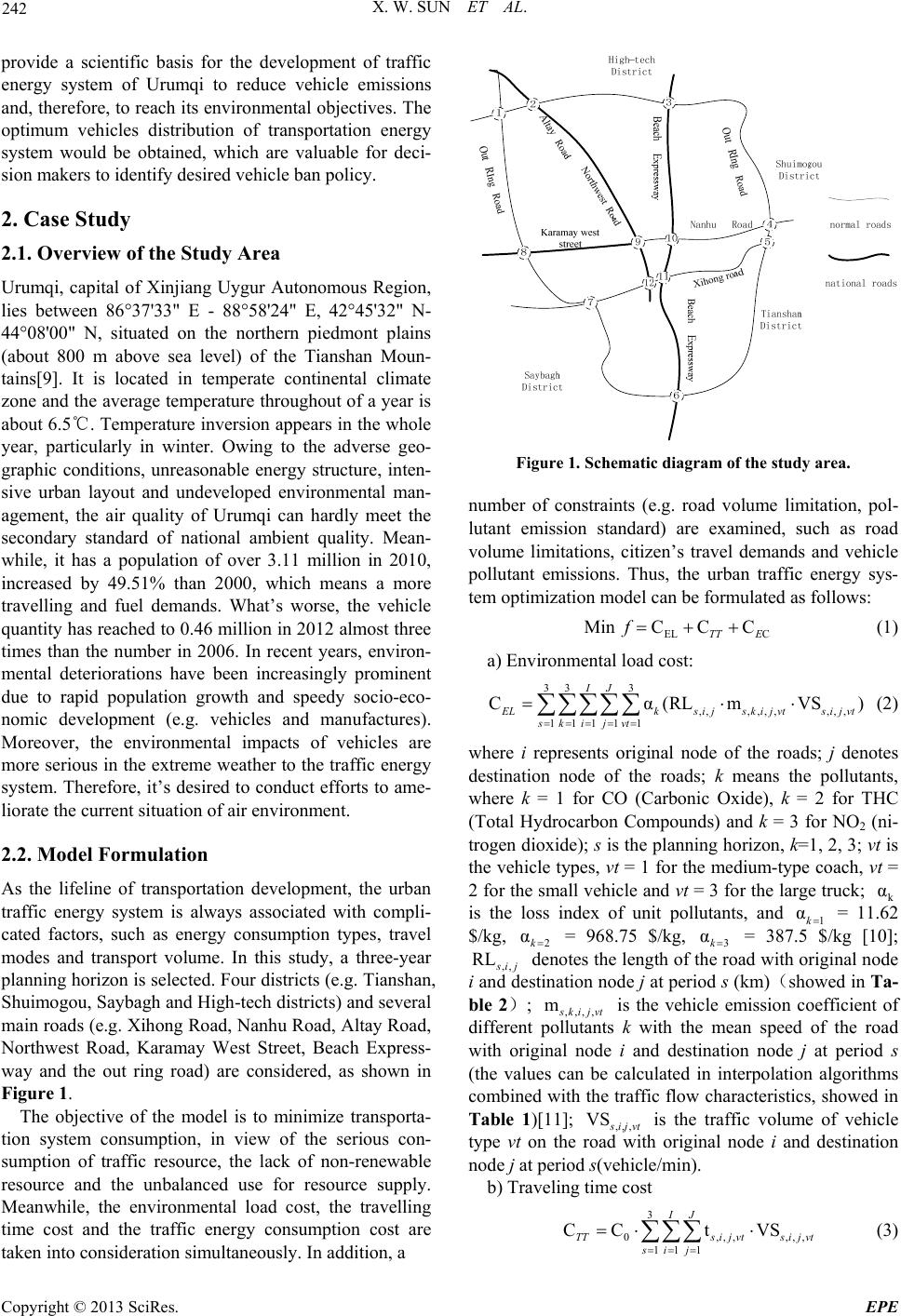 X. W. SUN ET AL. 242 provide a scientific basis for the development of traffic energy system of Urumqi to reduce vehicle emissions and, therefore, to reach its environmental objectives. The optimum vehicles distribution of transportation energy system would be obtained, which are valuable for deci- sion makers to identify desired vehicle ban policy. 2. Case Study 2.1. Overview of the Study Area Urumqi, capital of Xinjiang Uygur Autonomous Region, lies between 86°37'33" E - 88°58'24" E, 42°45'32" N- 44°08'00" N, situated on the northern piedmont plains (about 800 m above sea level) of the Tianshan Moun- tains[9]. It is located in temperate continental climate zone and the average temperature throughout of a year is about 6.5℃. Temperature inversion appears in the whole year, particularly in winter. Owing to the adverse geo- graphic conditions, unreasonable energy structure, inten- sive urban layout and undeveloped environmental man- agement, the air quality of Urumqi can hardly meet the secondary standard of national ambient quality. Mean- while, it has a population of over 3.11 million in 2010, increased by 49.51% than 2000, which means a more travelling and fuel demands. What’s worse, the vehicle quantity has reached to 0.46 million in 2012 almost three times than the number in 2006. In recent years, environ- mental deteriorations have been increasingly prominent due to rapid population growth and speedy socio-eco- nomic development (e.g. vehicles and manufactures). Moreover, the environmental impacts of vehicles are more serious in the extreme weather to the traffic energy system. Therefore, it’s desired to conduct efforts to ame- liorate the current situation of air environment. 2.2. Model Formulation As the lifeline of transportation development, the urban traffic energy system is always associated with compli- cated factors, such as energy consumption types, travel modes and transport volume. In this study, a three-year planning horizon is selected. Four districts (e.g. Tianshan, Shuimogou, Saybagh and High-tech districts) and several main roads (e.g. Xihong Road, Nanhu Road, Altay Road, Northwest Road, Karamay West Street, Beach Express- way and the out ring road) are considered, as shown in Figure 1. The objective of the model is to minimize transporta- tion system consumption, in view of the serious con- sumption of traffic resource, the lack of non-renewable resource and the unbalanced use for resource supply. Meanwhile, the environmental load cost, the travelling time cost and the traffic energy consumption cost are taken into consideration simultaneously. In addition, a Figure 1. Schematic diagram of the study ar ea. number of constraints (e.g. road volume limitation, pol- lutant emission standard) are examined, such as road volume limitations, citizen’s travel demands and vehicle pollutant emissions. Thus, the urban traffic energy sys- tem optimization model can be formulated as follows: EL C Min CCC TT E f (1) a) Environmental load cost: 33 3 ,,, ,, ,,, , 1111 1 Cα(RL mVS) IJ Lksijskijvt ski jvt sijvt (2) where i represents original node of the roads; j denotes destination node of the roads; k means the pollutants, where k = 1 for CO (Carbonic Oxide), k = 2 for THC (Total Hydrocarbon Compounds) and k = 3 for NO2 (ni- trogen dioxide); s is the planning horizon, k=1, 2, 3; vt is the vehicle types, vt = 1 for the medium-type coach, vt = 2 for the small vehicle and vt = 3 for the large truck; k is the loss index of unit pollutants, and 1 α αk = 11.62 $/kg, 2 αk = 968.75 $/kg, 3 αk = 387.5 $/kg [10]; ,, RL ij m denotes the length of the road with original node i and destination node j at period s (k m)(showed in Ta- ble 2); ,,,, kijvt is the vehicle emission coefficient of different pollutants k with the mean speed of the road with original node i and destination node j at period s (the values can be calculated in interpolation algorithms combined with the traffic flow characteristics, showed in Table 1)[11]; ,,, VS ijvt is the traffic volume of vehicle type vt on the road with original node i and destination node j at period s(vehicle/min). b) Traveling time cost 3 0,,, 11 1 CCt VS IJ TTs ij vts ij vt si j ,,, (3) Copyright © 2013 SciRes. EPE 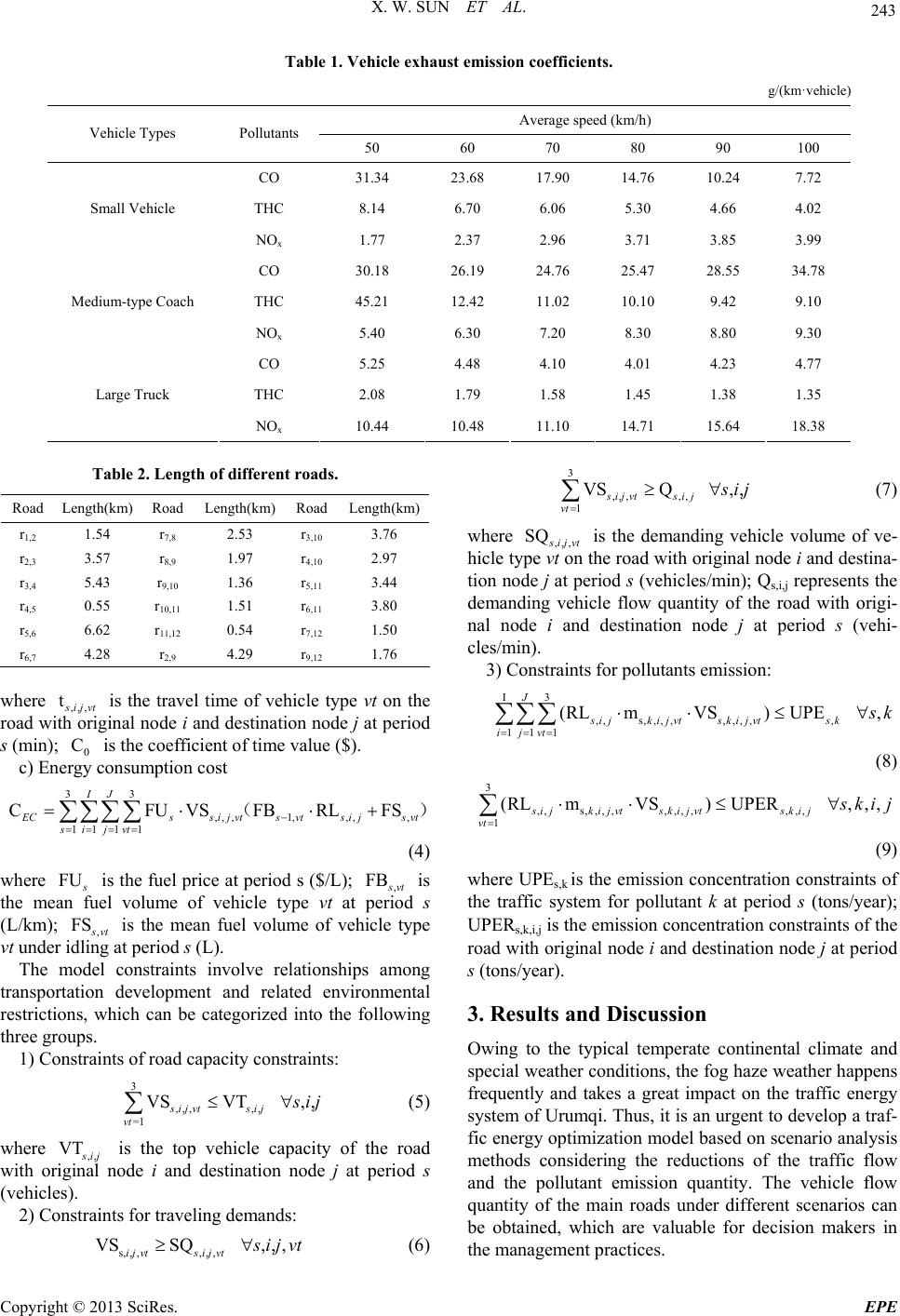 X. W. SUN ET AL. Copyright © 2013 SciRes. EPE 243 Table 1. Vehicle exhaust emission coefficients. g/(km·vehicle) Average speed (km/h) Vehicle Types Pollutants 50 60 70 80 90 100 CO 31.34 23.68 17.90 14.76 10.24 7.72 THC 8.14 6.70 6.06 5.30 4.66 4.02 Small Vehicle NOx 1.77 2.37 2.96 3.71 3.85 3.99 CO 30.18 26.19 24.76 25.47 28.55 34.78 THC 45.21 12.42 11.02 10.10 9.42 9.10 Medium-type Coach NOx 5.40 6.30 7.20 8.30 8.80 9.30 CO 5.25 4.48 4.10 4.01 4.23 4.77 THC 2.08 1.79 1.58 1.45 1.38 1.35 Large Truck NOx 10.44 10.48 11.10 14.71 15.64 18.38 Table 2. Length of different roads. 3 ,,, ,, 1 VSQ, , sijvtsi j vt ij (7) Road Length(km) Road Length(km) Road Length(km) r1,2 1.54 r7,8 2.53 r3,10 3.76 r2,3 3.57 r8,9 1.97 r4,10 2.97 r3,4 5.43 r9,10 1.36 r5,11 3.44 r4,5 0.55 r10,11 1.51 r6,11 3.80 r5,6 6.62 r11,12 0.54 r7,12 1.50 r6,7 4.28 r2,9 4.29 r9,12 1.76 where ,,, SQ ijvt is the demanding vehicle volume of ve- hicle type vt on the road with original node i and destina- tion node j at period s (vehicles/min); Qs,i,j represents the demanding vehicle flow quantity of the road with origi- nal node i and destination node j at period s (vehi- cles/min). 3) Constraints for pollutants emission: where ,,, t ijvt C is the travel time of vehicle type vt on the road with original node i and destination node j at period s (min); is the coefficient of time value ($). I3 ,,s, ,, ,, ,, ,, 111 (RLmVS) UPE, J s ijk ij vts k ij vts k ijvt k 0 c) Energy consumption cost (8) 33 ,, ,1,,,, 11 11 CFUVSFBRL IJ FS Cssi jvtsvtsi jsvt si jvt () (4) 3 ,,s, ,, ,, ,, ,, ,, 1 (RLmVS)UPER,, , sij kijvtskijvtskij vt kij (9) where UPEs,k is the emission concentration constraints of the traffic system for pollutant k at period s (tons/year); UPERs,k,i,j is the emission concentration constraints of the road with original node i and destination node j at period s (tons/year). where FU is the fuel price at period s ($/L); , FB vt is the mean fuel volume of vehicle type vt at period s (L/km); , FS vt is the mean fuel volume of vehicle type vt under idling at period s (L). The model constraints involve relationships among transportation development and related environmental restrictions, which can be categorized into the following three groups. 3. Results and Discussion Owing to the typical temperate continental climate and special weather conditions, the fog haze weather happens frequently and takes a great impact on the traffic energy system of Urumqi. Thus, it is an urgent to develop a traf- fic energy optimization model based on scenario analysis methods considering the reductions of the traffic flow and the pollutant emission quantity. The vehicle flow quantity of the main roads under different scenarios can be obtained, which are valuable for decision makers in the management practices. 1) Constraints of road capacity constraints: 3 ,,, ,, =1 VSVT, , sijvt sij vt ij (5) where ,, VT ij is the top vehicle capacity of the road with original node i and destination node j at period s (vehicles). 2) Constraints for traveling demands: s, , ,, , , VSSQ,, , ijvt sijvt ijvt (6) 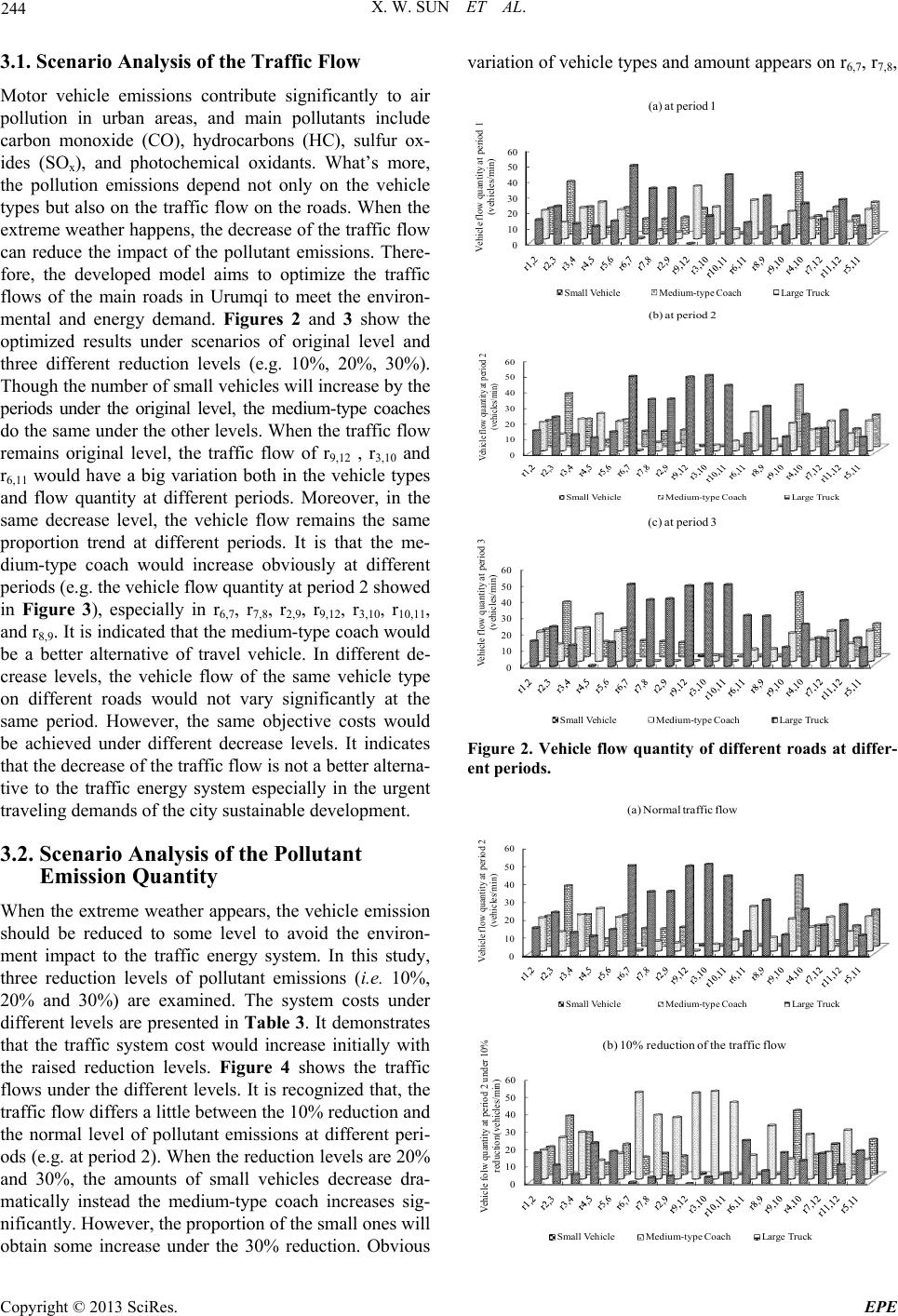 X. W. SUN ET AL. 244 3.1. Scenario Analysis of the Traffic Flow Motor vehicle emissions contribute significantly to air pollution in urban areas, and main pollutants include carbon monoxide (CO), hydrocarbons (HC), sulfur ox- ides (SOx), and photochemical oxidants. What’s more, the pollution emissions depend not only on the vehicle types but also on the traffic flow on the roads. When the extreme weather happens, the decrease of the traffic flow can reduce the impact of the pollutant emissions. There- fore, the developed model aims to optimize the traffic flows of the main roads in Urumqi to meet the environ- mental and energy demand. Figures 2 and 3 show the optimized results under scenarios of original level and three different reduction levels (e.g. 10%, 20%, 30%). Though the number of small vehicles will increase by the periods under the original level, the medium-type coaches do the same under the other levels. When the traffic flow remains original level, the traffic flow of r9,12 , r3,10 and r6,11 would have a big variation both in the vehicle types and flow quantity at different periods. Moreover, in the same decrease level, the vehicle flow remains the same proportion trend at different periods. It is that the me- dium-type coach would increase obviously at different periods (e.g. the vehicle flow quantity at period 2 showed in Figure 3), especially in r6,7, r7,8, r2,9, r9,12, r3,10, r10,11, and r8,9. It is indicated that the medium-type coach would be a better alternative of travel vehicle. In different de- crease levels, the vehicle flow of the same vehicle type on different roads would not vary significantly at the same period. However, the same objective costs would be achieved under different decrease levels. It indicates that the decrease of the traffic flow is not a better alterna- tive to the traffic energy system especially in the urgent traveling demands of the city sustainable development. 3.2. Scenario Analysis of the Pollutant Emission Quantity When the extreme weather appears, the vehicle emission should be reduced to some level to avoid the environ- ment impact to the traffic energy system. In this study, three reduction levels of pollutant emissions (i.e. 10%, 20% and 30%) are examined. The system costs under different levels are presented in Table 3. It demonstrates that the traffic system cost would increase initially with the raised reduction levels. Figure 4 shows the traffic flows under the different levels. It is recognized that, the traffic flow differs a little between the 10% reduction and the normal level of pollutant emissions at different peri- ods (e.g. at period 2). When the reduction levels are 20% and 30%, the amounts of small vehicles decrease dra- matically instead the medium-type coach increases sig- nificantly. However, the proportion of the small ones will obtain some increase under the 30% reduction. Obvious variation of vehicle types and amount appears on r6,7, r7,8, 0 10 20 30 40 50 60 Vehicle flow quantity at period 1 (vehicles/min) (a) at period 1 Small VehicleMedium-type CoachLarge Truck 0 10 20 30 40 50 60 Vehicle flow quantity at period 2 (vehicles/min) (b) at period 2 Small VehicleMedium-type CoachLarge Truck 0 10 20 30 40 50 60 Vehicle flow quantity at period 3 (vehicles/min) (c) at period 3 Small VehicleMedium-type CoachLarge Truck Figure 2. Vehicle flow quantity of different roads at differ- ent periods. 0 10 20 30 40 50 60 Vehicle flow quantity at period 2 (vehicles/min) (a) Normal traffic flow Small VehicleMedium-type CoachLarge Truck 0 10 20 30 40 50 60 Vehicle folw quantity at period 2 under 10% reduction(vehicles/min) (b) 10% reduction of the traffic flow Small VehicleMedium-type CoachLarge Truck Copyright © 2013 SciRes. EPE 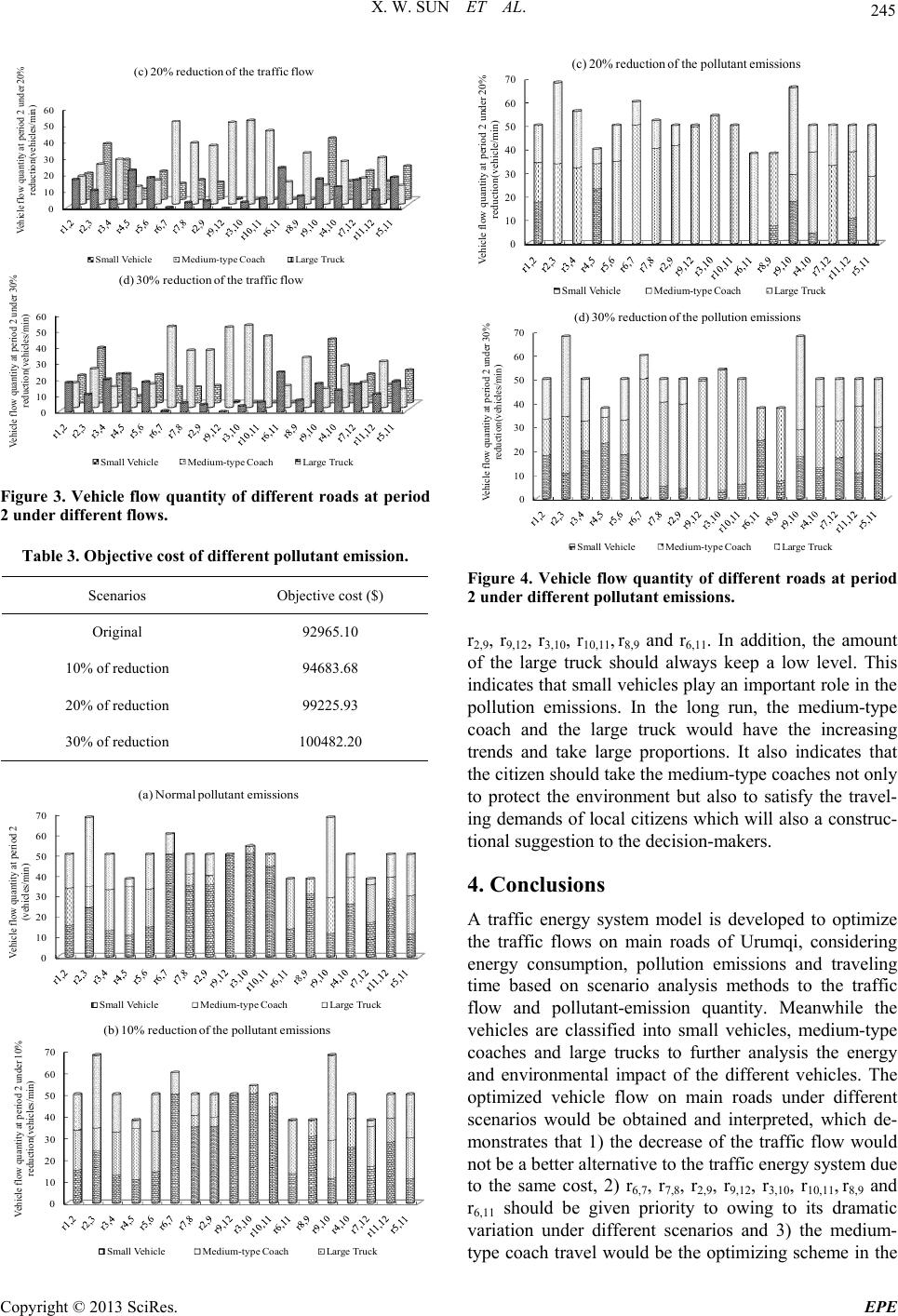 X. W. SUN ET AL. 245 0 10 20 30 40 50 60 Vehicle flow quantity at period 2 under 20% reduction(vehicles/min) (c) 20% reduction of the traffic flow Small VehicleMedium-type CoachLarge Truck 0 10 20 30 40 50 60 Vehicle flow quantity at period 2 under 30% reduction(vehicles/min) (d) 30% reduction of the traffic flow Small VehicleMedium-type CoachLarge Truck Figure 3. Vehicle flow quantity of different roads at period 2 under different flows. Table 3. Objective cost of different pollutant emission. Scenarios Objective cost ($) Original 92965.10 10% of reduction 94683.68 20% of reduction 99225.93 30% of reduction 100482.20 0 10 20 30 40 50 60 70 Vehicle flow quantity at period 2 (veh i cles/mi n ) (a) Normal pollutant emissions Small VehicleMedium-type CoachLarge Truck 0 10 20 30 40 50 60 70 Vehicle flow quantity at period 2 under 10% reduction(vehicles/min) (b) 10% reduction of the pollutant emissions Small VehicleMedium-type CoachLarge Truck 0 10 20 30 40 50 60 70 Vehicle flow quantity at period 2 under 20% reduction(vehicle/min) (c) 20% reduction of the pollutant emissions Small VehicleMedium-type CoachLarge Truck 0 10 20 30 40 50 60 70 Vehicle flow quantity at period 2 under 30% red uctio n(vehicl es /min) (d) 30% reduction of the pollution emissions Small VehicleMedium-type CoachLarge Truck Figure 4. Vehicle flow quantity of different roads at period 2 under different pollutant emissions. r2,9, r9,12, r3,10, r10,11, r8,9 and r6,11. In addition, the amount of the large truck should always keep a low level. This indicates that small vehicles play an important role in the pollution emissions. In the long run, the medium-type coach and the large truck would have the increasing trends and take large proportions. It also indicates that the citizen should take the medium-type coaches not only to protect the environment but also to satisfy the travel- ing demands of local citizens which will also a construc- tional suggestion to the decision-makers. 4. Conclusions A traffic energy system model is developed to optimize the traffic flows on main roads of Urumqi, considering energy consumption, pollution emissions and traveling time based on scenario analysis methods to the traffic flow and pollutant-emission quantity. Meanwhile the vehicles are classified into small vehicles, medium-type coaches and large trucks to further analysis the energy and environmental impact of the different vehicles. The optimized vehicle flow on main roads under different scenarios would be obtained and interpreted, which de- monstrates that 1) the decrease of the traffic flow would not be a better alternative to the traffic energy system due to the same cost, 2) r6,7, r7,8, r2,9, r9,12, r3,10, r10,11, r8,9 and r6,11 should be given priority to owing to its dramatic variation under different scenarios and 3) the medium- type coach travel would be the optimizing scheme in the Copyright © 2013 SciRes. EPE 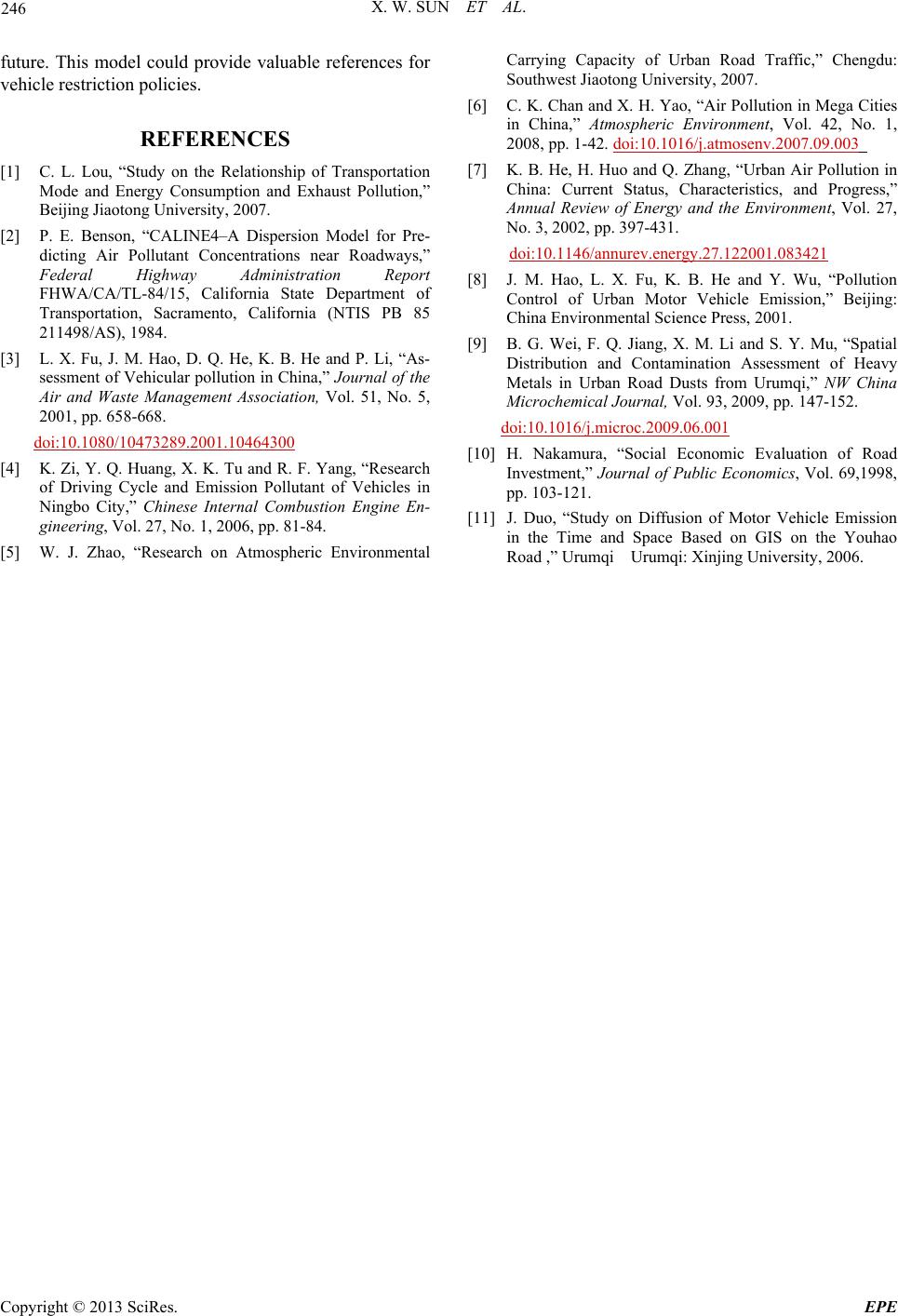 X. W. SUN ET AL. Copyright © 2013 SciRes. EPE 246 future. This model could provide valuable references for vehicle restriction policies. REFERENCES [1] C. L. Lou, “Study on the Relationship of Transportation Mode and Energy Consumption and Exhaust Pollution,” Beijing Jiaotong University, 2007. [2] P. E. Benson, “CALINE4–A Dispersion Model for Pre- dicting Air Pollutant Concentrations near Roadways,” Federal Highway Administration Report FHWA/CA/TL-84/15, California State Department of Transportation, Sacramento, California (NTIS PB 85 211498/AS), 1984. [3] L. X. Fu, J. M. Hao, D. Q. He, K. B. He and P. Li, “As- sessment of Vehicular pollution in China,” Journal of the Air and Waste Management Association, Vol. 51, No. 5, 2001, pp. 658-668. doi:10.1080/10473289.2001.10464300 [4] K. Zi, Y. Q. Huang, X. K. Tu and R. F. Yang, “Research of Driving Cycle and Emission Pollutant of Vehicles in Ningbo City,” Chinese Internal Combustion Engine En- gineering, Vol. 27, No. 1, 2006, pp. 81-84. [5] W. J. Zhao, “Research on Atmospheric Environmental Carrying Capacity of Urban Road Traffic,” Chengdu: Southwest Jiaotong University, 2007. [6] C. K. Chan and X. H. Yao, “Air Pollution in Mega Cities in China,” Atmospheric Environment, Vol. 42, No. 1, 2008, pp. 1-42. doi:10.1016/j.atmosenv.2007.09.003 [7] K. B. He, H. Huo and Q. Zhang, “Urban Air Pollution in China: Current Status, Characteristics, and Progress,” Annual Review of Energy and the Environment, Vol. 27, No. 3, 2002, pp. 397-431. doi:10.1146/annurev.energy.27.122001.083421 [8] J. M. Hao, L. X. Fu, K. B. He and Y. Wu, “Pollution Control of Urban Motor Vehicle Emission,” Beijing: China Environmental Science Press, 2001. [9] B. G. Wei, F. Q. Jiang, X. M. Li and S. Y. Mu, “Spatial Distribution and Contamination Assessment of Heavy Metals in Urban Road Dusts from Urumqi,” NW China Microchemical Journal, Vol. 93, 2009, pp. 147-152. doi:10.1016/j.microc.2009.06.001 [10] H. Nakamura, “Social Economic Evaluation of Road Investment,” Journal of Public Economics, Vol. 69,1998, pp. 103-121. [11] J. Duo, “Study on Diffusion of Motor Vehicle Emission in the Time and Space Based on GIS on the Youhao Road ,” Urumqi Urumqi: Xinjing University, 2006.
|